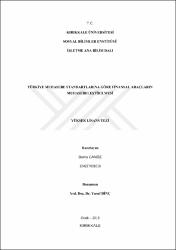| dc.contributor.advisor | Dinç, Doç. Yusuf | |
| dc.contributor.author | Canöz, Burcu | |
| dc.date.accessioned | 2021-01-16T19:01:06Z | |
| dc.date.available | 2021-01-16T19:01:06Z | |
| dc.date.issued | 2018 | |
| dc.identifier.uri | | |
| dc.identifier.uri | https://hdl.handle.net/20.500.12587/15289 | |
| dc.description | YÖK Tez ID: 531546 | en_US |
| dc.description.abstract | Finansal piyasalardaki küreselleşme ile birlikte mal, hizmet ve sermaye hareketleri ulusal boyuttan çıkıp uluslararası bir boyutta gerçekleşmeye başlamıştır. Oluşan bu yeni ortamda işletmeler, maruz kaldıkları riskleri önleyebilmek ve faaliyetlerini devam ettirebilmek için temel finansal araçlara alternatif olabilecek yeni finansal araçlara ihtiyaç duymuşlardır. Bu yeni finansal araçlar, dayanak varlığı temel finansal araçlar olan türev araçlardır. Temel amacı riski devretmek ve riskten korunmak olan bu araçlar zaman içerisinde kar etme ve kazanç sağlama amacıyla da kullanılır hale gelmiştir. Piyasalarda risk yönetim anlayışının ortaya çıkması türev araçların kullanımında büyük ölçüde bir artışa sebep olmuştur. Türev araçların işlem hacmindeki bu artış bazı sorunları da beraberinde getirmiştir. Bu sorunların başında, bilanço dışı kalemler olarak kabul edilen türev araçların muhasebe kayıtlarında nasıl gösterilmesi gerektiğidir. Türev araç kullanıcıları açısından, bu araçların finansal tablolarda nasıl raporlanacağı, hangi değerleme ölçüsünün kullanılacağı, bu araçlardan doğan kazanç ve kayıpların finansal tablolara ne zaman ve nasıl aktarılacağı, büyük önem arz etmektedir. Türkiye Muhasebe Standartları 32 ve 39, finansal araçların değerlemesi ve muhasebeleştirilmesine ilişkin ilkeleri ortaya koymaktadır. Bu tez çalışması finansal araçlardan türetilmiş olan türev araçların kullanım amaçlarını, değerlemesini, muhasebeleştirilmesini, türev araçlarla ilgili yayınlanan muhasebe standartlarını açıklanmak ve türev araç sözleşmelerinin muhasebe kayıtlarını örneklendirmek amacıyla hazırlanmıştır. | en_US |
| dc.description.abstract | With the globalization movement on the financial markets, the transactions of goods, services, and capitals have started to take place at an international level rather than just national. In this new emerging environment, businesses needed to find new financial instruments that could be an alternative to the basic financial instruments they have in order to be able to avoid risks they get exposed to and continue their operations. These new financial instruments are derivatives of the existing basic financial instruments. These instruments, which have the main purpose of protecting from the risk and transferring the risk, have also started to become used in order to acquire profits and gains through time. The emergence of the risk management approach in the financial markets has led to a major increase in the use of these derivative instruments. This increase in the trading volume of derivative instruments has also brought some problems. The first of these problems is the question of how derivative instruments that are considered as off-balance-sheet items should be presented in the accounting records. Amongst the users of these derivative instruments, questions such as; how to report these instruments in the financial statements, which valuation measures will be used, when and how the gains and losses caused by these instruments will be transferred to the financial statements, carry great importance. Turkish accounting standards 32 and 39 have revealed principles that relation with valuation and accounting of financial instruments. This thesis study has been prepared to explain the purpose of use, valuation, and recognition of derivative instruments which derived from financial instruments, to explain published accounting standards about these instruments and to exemplify the accounting records of derivative instruments contracts. | en_US |
| dc.language.iso | tur | en_US |
| dc.publisher | Kırıkkale Üniversitesi | en_US |
| dc.rights | info:eu-repo/semantics/openAccess | en_US |
| dc.subject | İşletme | en_US |
| dc.subject | Business Administration | en_US |
| dc.title | Türkiye Muhasebe Standartlarına göre finansal araçların muhasebeleştirilmesi | en_US |
| dc.title.alternative | Accounting of financial instruments according to Turkish Accounting Standards | en_US |
| dc.type | masterThesis | en_US |
| dc.contributor.department | KKÜ, Sosyal Bilimler Enstitüsü, İşletme Anabilim Dalı | en_US |
| dc.identifier.startpage | 1 | en_US |
| dc.identifier.endpage | 129 | en_US |
| dc.relation.publicationcategory | Tez | en_US |
















